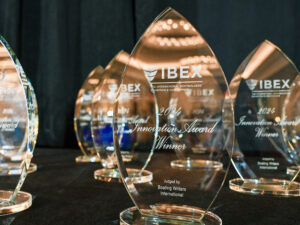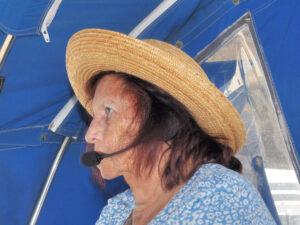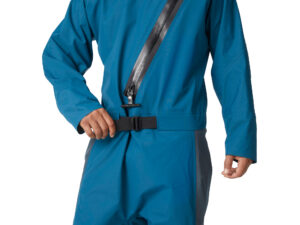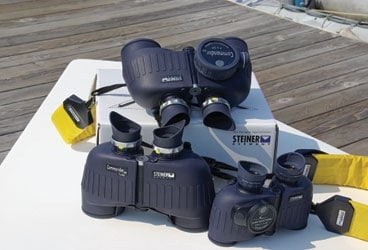
Steiners 368
The editors at Cruising World have spent a good deal of time on the water lately, some of which we devoted to testing binoculars. Most recently, pairs by Steiner and Fujinon (see opposite page) were made available to us. As a group, we found them to be the clearest we’d used in years. While we had them, we liked the Steiners a lot, but to get more opinions, we asked some knowledgeable friends to give them a try, too.
“Great feel,” said Peter Rugg, winner of the Newport-Bermuda Race doublehanded division in 2002, describing the powerful 7×50 Commander XPC, which he took on the Marblehead-to-Halifax Ocean Race in July 2007. “The clarity is eye-popping. At dusk, they seem to gather light, and in bright sun, they cut glare. The bearing compass is damped to perfection.”
Robin Wallace, a nationally known US Sailing principal race officer, tried the 7×50 Commander XP during a regatta on Narragansett Bay, in Rhode Island. “They’re incredibly bright,” he said. “And the light-gathering properties are amazing.”
I took the much smaller 7×30 Navigator Pro C with me during the 2007 Shields National Championships, in Newport, Rhode Island. Some marks were more than two miles away and very difficult to locate-especially when the spray was flying during the 30-knot winds on the last day. As expected, the binoculars performed brilliantly, though both tactician Roy Williams-a sailing coach with more than a few offshore miles logged-and I felt that the bearing compass was difficult to use. But we spotted the marks much sooner than we would have using bare eyes and felt we had a leg up on the competition as a result. The glasses stood up to being bounced around and totally immersed in salt water without showing any signs of adverse effects. Roy said the rubber eyecups were comfortable to use and fit well enough that they kept the salt spray out of his eyes. As our boat was tossed around on the waves, the Navigator Pro C binoculars, with their smaller field of vision, were easier to keep steady than more powerful glasses we had on board.
Each pair of binoculars is waterproof and comes with a 10-year warranty. Rubber cladding makes them easy to grip and provides cushioning for the inevitable bumps that occur during normal use. The clarity we all noted is due to optics that allow 96 percent of the light to pass through to the user’s eye.
For more information on the above models and other Steiner products, consult the company’s website (www.steiner-binoculars.com).
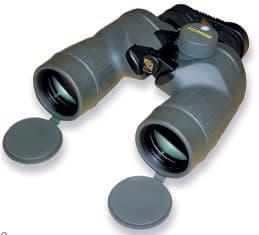
Courtesy of the Manufacturer|
|Fujinon Polaris Binoculars|
Fujinon Polaris Binoculars
The 7×50 Polaris FMTRC-SX binoculars from Fujinon (www.fujinonbinos.com) provide an exceptionally bright and distortion-free view. We used them aboard White Knight in the Cruising Class during Antigua Sailing Week and during the subsequent 100-mile night passage to Sint Maarten, where they got a good trial. Our Italian crew was impressed with the clear, flat view that had no distortion at the edge of the field of vision. They seemed to cut through the tropical haze, allowing us to find the next mark before our competition did.
During the wet, wavy passage to Sint Maarten, we were in company with a couple of other boats. Not a twinkle of starlight made it through the clouds hanging low over the boat, yet we were able to pick out details of the other two boats with no problem, thanks to the Fujinon’s excellent light-gathering properties. We found the built-in compass very easy to use and well-damped as we kept track of the other boats’ bearings. We kept the binoculars in the cockpit, where the occasional rain shower and odd drenching wave were no worry for these rubber-armored waterproof glasses. The rubber eyecups were comfortable to use, too.
The boat had a set of high-quality 7x50s aboard, but the pair was 15 years old, and the difference in the technology between the old and new is remarkable. Of course, quality comes at a price, and the Fujinons aren’t cheap at $1,160.
What the Two Numbers Mean
You’ll always see binoculars described by two numbers. The first refers to magnification; the higher this number, the more powerful the magnification. Note that for practical purposes, any magnification greater than 7x is hard to hold steady on the water. The second number refers to the diameter of the outer lens; larger numbers mean that more light is transmitted to the user’s eye, which will make the image brighter.
Andrew Burton is a Cruising World associate editor.
Binoculars Tested
Model Weight (ounces) Price
Steiner 7×50 Commander XP 37 $700
Steiner 7×50 Commander XPC 39 $875
Steiner 7×30 Navigator Pro C 20 $350
Fujinon 7×50 Polaris FMTRC-SX 52 $1,160

